Bettas are one of the most popular fish for aquarists of all levels and many betta-keepers chose to combine their love of fish with their love of gardening to give their fish a natural planted environment. So what are the best plants to keep with bettas? The choices are endless! We’ll discuss a few options here as well as how to choose the best plants and how to set up your display.
Before we begin, it is important to note that the plant DOES NOT feed the betta! When the trend of keep a plant on top of a betta bowl first became popular, it was a common misconception that the betta would feed on the roots of the betta and wouldn’t need to be fed…that could hardly be farther from the truth. Bettas are carnivores, meaning they eat meaty food…NOT plants. A betta seen nibbling at a plant is more likely bored, starving, or picking off tiny animals on the surface of the plant. Even if you have live plants in the tank, you still need to feed your fish.
While bettas can be kept in tanks or large bowls (preferably at least 1 gallon at the absolute bare minimum) without a filter, the lack of filter means that the water would need to be changed more frequently. Those frequent changes can actually be harmful to some plants (especially rooted or bulb plants) if they are disturbed often.
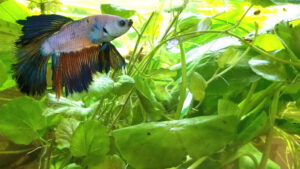
On to choosing your plants…
Aquarium Plants:
This one may seem obvious but any live aquarium plants would be safe with a betta. The key is making sure that the water parameters and lighting on the tank are suitable for the plant. You can consult a Plant Requirements Chart like ours to make sure your lighting, hardness and other parameters are suitable. If your tank doesn’t have its own lighting, consider investing in a fixture if you would like higher-light plants or stick to low-light species. These plants are all generally tropical, meaning they need water at a consistent temperature, usually about 74-78 degrees…coincidentally, the same temperature your betta will thrive at as well. You may need a heater in the tank for both the fish and plants if your tank is in a cooler location or somewhere drafty that may cause the water temperature to be inconsistent. The plants (and fish) will also thrive better with a filter and gentle water movement.
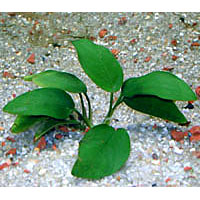 Some popular and easy choices are fast-growing stalk plants like Anacharis, Hornwort, Myrio, Ludwigia and countless others. These plants are typically sold in bunches held together with a lead weight or rubberband. This should be removed when the plant is added to the tank and the stalks planted individually or left floating for some plants. Java Fern and Anubias plants are also popular low-light choices. These plants grow from a rhizome with roots coming from it that should be planted in the substrate. They would benefit from a plant substrate rather than decorative gravel and should be disturbed as little as possible once they are planted. Mosses are also good for betta tanks as well as floating plants like Duckweed or Azolla (just make sure they are allowed in your area as some areas prohibit some floating plants as invasive species). Many tissue-culture plants are also good for bettas since they are offered at a smaller size and are snail-free.
Some popular and easy choices are fast-growing stalk plants like Anacharis, Hornwort, Myrio, Ludwigia and countless others. These plants are typically sold in bunches held together with a lead weight or rubberband. This should be removed when the plant is added to the tank and the stalks planted individually or left floating for some plants. Java Fern and Anubias plants are also popular low-light choices. These plants grow from a rhizome with roots coming from it that should be planted in the substrate. They would benefit from a plant substrate rather than decorative gravel and should be disturbed as little as possible once they are planted. Mosses are also good for betta tanks as well as floating plants like Duckweed or Azolla (just make sure they are allowed in your area as some areas prohibit some floating plants as invasive species). Many tissue-culture plants are also good for bettas since they are offered at a smaller size and are snail-free.
Partially-submerged plants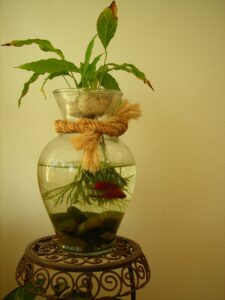
Many planted betta tanks can give you the opportunity to really think outside the box…literally. Some popular “betta plants” actually do much better with part of the plant extending above the water level. The two most common of these plants are the Brazilian Sword (also known as a “Peace Lily”) and “Lucky Bamboo”. For both of these, you can either plant the plant into the substrate so the top sticks out of the water or suspend the plant towards the top of the tank. We’ll cover how to do that later.
“House plants”
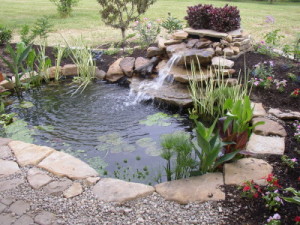 This is what we get questions about the most… “Can I keep my <insert plant here> in with my betta?” Unfortunately, there’s no easy answer but we can help you find the answer. The most important thing to consider here is the moisture level of the plant. Any plant that needs dry soil – cactus, succulents, Aloe, etc. – can’t be kept in a wet environment and would make a poor choice for your betta. At best, the plant wouldn’t survive. At worse, the dying plant would pollute the water and take the betta out with it. Instead, look for plants that can handle constantly wet soil. During the spring and summer, you can look for plants sold for outdoor ponds as “bog plants” or “marginal plants”. These plants live at the edges of ponds or swamps and are used to having their roots in water. Some popular species of these plants are the Peace Lilies and Bamboo we mentioned above as well as some ivy, Philodendrons, Spider Plants, Water Clover, Sensitive Plant, Violets and many more. Many plants sold as pond plants can grows very large or need full sunlight so just make sure you consider the needs of the plant carefully before adding it to your tank. As with any plants, you may need to prune or trim the plant as it grows so it doesn’t take over the tank. Also, some fertilizers or insecticides can be harmful to the betta so choose your plant carefully.
This is what we get questions about the most… “Can I keep my <insert plant here> in with my betta?” Unfortunately, there’s no easy answer but we can help you find the answer. The most important thing to consider here is the moisture level of the plant. Any plant that needs dry soil – cactus, succulents, Aloe, etc. – can’t be kept in a wet environment and would make a poor choice for your betta. At best, the plant wouldn’t survive. At worse, the dying plant would pollute the water and take the betta out with it. Instead, look for plants that can handle constantly wet soil. During the spring and summer, you can look for plants sold for outdoor ponds as “bog plants” or “marginal plants”. These plants live at the edges of ponds or swamps and are used to having their roots in water. Some popular species of these plants are the Peace Lilies and Bamboo we mentioned above as well as some ivy, Philodendrons, Spider Plants, Water Clover, Sensitive Plant, Violets and many more. Many plants sold as pond plants can grows very large or need full sunlight so just make sure you consider the needs of the plant carefully before adding it to your tank. As with any plants, you may need to prune or trim the plant as it grows so it doesn’t take over the tank. Also, some fertilizers or insecticides can be harmful to the betta so choose your plant carefully.
Suspending your plants
As we mentioned above, may popular set up with plants involve suspending the plant above the level of the tank. The most common of these is the hourglass-shaped betta vase with a “Peace Lily” (the Brazilian Sword from earlier) suspended at the neck of the vase but any plants that need their leafy bits above the water level can be kept this way. There are many ways to accomplish this and depend on the size, shape and setup of your tank. Some modern, high-end tanks even have a built-in section just for a live plant above the water but even if yours doesn’t you can create your own.
If you have a vase or tank with a narrow opening, you can set the bowl containing your plant right on top….just be sure to keep a fair amount of space between the water level and top of the vase, because bettas need an open space to breathe atmospheric air. If your tank has nothing to support the plant dish, you can suspend it using supports like bamboo rods, dowels, chopsticks or a similar material that is strong enough and will keep its strength with the moisture…avoid anything that will soften or metal that may rust. You can also use clips to hold the cup onto the side of the tank as long as they are strong enough to support the plant without stressing the tank. For a few ideas, check out these photos:

For the cup itself, you can use a clean plastic cup like the one pictured here in any size suitable for your tank and the plant, or a pot made of a plant-safe material like terracotta (as long as the support system can hold it). If the dish you choose doesn’t have a hole or holes for the roots to extend 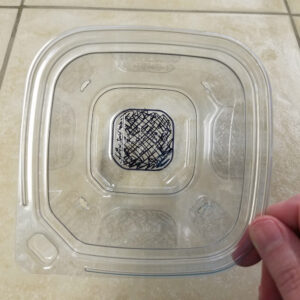 through, cut the center out while leaving a ledge around it so you can add some stones to support the plant. With the cup we used in our example, I would cut out the black area in the center. When adding some stones to keep the plant upright, it is best to use larger pebbles or gravel so it doesn’t fall through the hole into the tank below.
through, cut the center out while leaving a ledge around it so you can add some stones to support the plant. With the cup we used in our example, I would cut out the black area in the center. When adding some stones to keep the plant upright, it is best to use larger pebbles or gravel so it doesn’t fall through the hole into the tank below.
Hopefully, these ideas help you with some ideas for your own new betta display. As always, feel free to let us know if you have any questions or need help making your idea a reality!
For more information on bettas and their care, please read these helpful articles in our archives:
http://blogs.thatpetplace.com/thatfishblog/2008/06/26/carnival-fish-part-2-the-betta/
 That Fish Blog – Aquarium Advice and Information
That Fish Blog – Aquarium Advice and Information

 The African fan shrimp is not well established in the aquarium trade, but interest is growing. I have maintained a group for approximately 2 years, and have found them to be fascinating, if a bit challenging in some respects. Their mode of feeding is particularly interesting, but requires a bit of attention as to “presentation”…I’ll write more about that in Part II of this article.
The African fan shrimp is not well established in the aquarium trade, but interest is growing. I have maintained a group for approximately 2 years, and have found them to be fascinating, if a bit challenging in some respects. Their mode of feeding is particularly interesting, but requires a bit of attention as to “presentation”…I’ll write more about that in Part II of this article. This shrimp inhabits rocky streams along the west coast of Africa, from Senegal to Gabon. It is also recorded from the east coast of South America; however, the genus is not well studied and these populations may represent a different species. Their natural history is not well-documented.
This shrimp inhabits rocky streams along the west coast of Africa, from Senegal to Gabon. It is also recorded from the east coast of South America; however, the genus is not well studied and these populations may represent a different species. Their natural history is not well-documented.